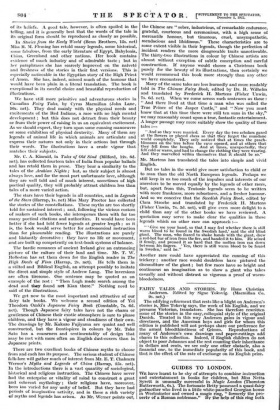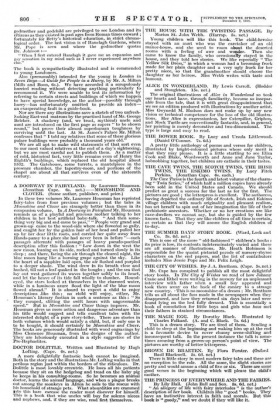GUIDES TO LONDON.
WE have learnt to be shy of attempts to combine instruction and entertainment in books for children but Miss Netta Syrett is unusually successful in Magic London (Thornton Butterworth, Os.). The fortunate Betty possessed a quasi-fairy godmother who lived in a little white-panelled Georgian house in Westminster and owned a magic ring, "formerly the pro- per& of a Roman nobleman." By the help of this ring both
godmother and godchild are privileged to see London and its citizens as they existed in past ages from Roman times onward ; fortunately for Betty's -historical education, in strict chrono- logical order. The last vision is of Ranelagh Gardens, where Mr. Pope is seen and where the godmother quotes Dr. Johnson :—
"When I first entered R.anelagh it gave me an expansion and gay sensation in my mind such as I never experienced anywhere else."
The book is sympathetically illustrated and is commended to young Londoners. Also (presumably) intended for the young is London in Seven Days—A Guide for People in a Hurry, by Mr. A. Milton (Mills and Boon, 6s.). We have accorded it a scrupulously hurried reading without detecting anything particularly to recommend it. We were unable to test its information by referring to certain streets and buildings of which we happen to have special knowledge, as the author—possibly through hurry—has unfortunately omitted to provide an index— an exasperating fault in a guide-book. Nor are there any illustrations save a sketch of two unfresh- ?Joking East-end matrons by the practised hand of Mr. George Belcher. A shadowy (and, we trust, mythical) uncle and aunt are introduced on the first page as supers "to be shown round," but prove their almost superhuman toughness by surviving until the last. At St. James's Palace Mr. Milton confesses that " I told my relatives that some of these glorious palace buildings were probably a thousand years old.'
We are all apt to make wild statements of that sort even to our most valued relatives at the end of a day's sightseeing, but we are most careful not to publish them. As a matter of cold, historical fact, very little remains even of Henry the Eighth's buildings, which replaced the old hospital about 1532. The Gatehouse, some turrets, a mantelpiece in the presence chamber, the tapestry-room, and portions of the chapel are about all that survives even of the sixteenth century.







































































 Previous page
Previous page